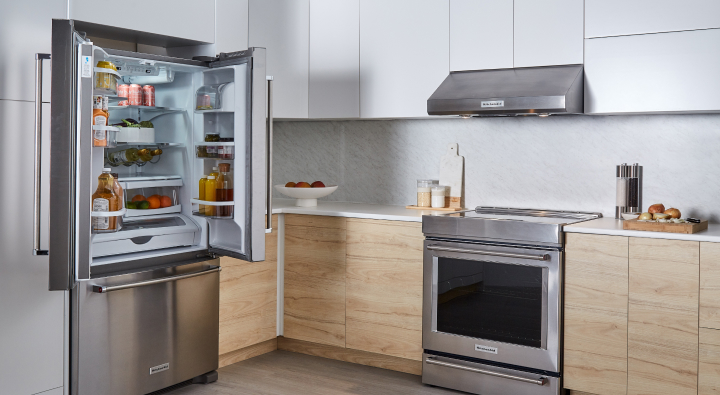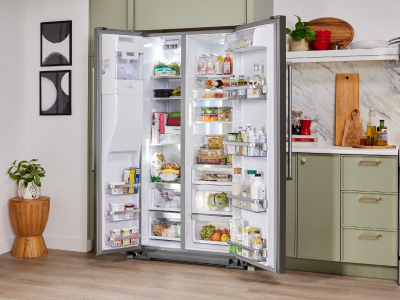
Why is my refrigerator freezing food?
You use your refrigerator to store all of your favorite fresh ingredients, but it can be frustrating to find frost on your food when you open the door. If your refrigerator is freezing food, there are several possible causes to consider. Use this guide to explore possible solutions for a refrigerator that is getting too cold and discover tips to prevent the issue in the future.


Why is my refrigerator freezing food on the lowest setting?
Refrigerators work to keep your food at a cool—but not freezing—temperature. Overly frosty temperatures in your refrigerator can be due to a few possible causes, including blocked air vents, incorrect temperature settings, leaky door seals, issues with your built-in ice maker and more.


Possible fixes for a refrigerator that is freezing food
If your refrigerator begins to freeze your fresh produce and meats, there are a few possible fixes you can try before calling in the professionals. Explore some potential solutions for a refrigerator that’s too cold below.
1. Unblock the air vent
The air vents inside your refrigerator help circulate cold air throughout the interior to maintain proper cooling temperatures. If you overpack your appliance, you may have blocked the air vent. This can restrict the airflow and lead to freezing temperatures inside the refrigerator storage area.
Organize the contents of your refrigerator and make sure your items are evenly distributed throughout the storage area and are not crowding the air vents.
2. Fix temperature settings
Proper internal temperatures for a refrigerator range between 38–40ºF. If you notice your refrigerated food is frozen, you may need to reset the temperature settings on your appliance, following the instructions provided in the owner’s manual.
3. Check the gasket seals
Your refrigerator door is wrapped with rubber gasket seals that help lock in cold air and maintain the refrigerator’s internal temperature. If the seal is damaged or broken, it can lead to temperature issues inside the appliance. Inspect the gasket seals for cracks, tears or any other visible sign of wear. If damage is found, the seals may need to be replaced.
4. Adjust built-in ice maker settings
If your refrigerator has a built-in ice maker, it could be the culprit behind the freezing temperatures. Ice makers that are powered on but disconnected from the water supply may continue trying to make ice, which can release too much cold air inside your refrigerator and alter the internal temperature.
You can resolve this issue by either connecting your ice maker to a water line or by switching the power setting to the “off” position.
5. Clean the condenser coils
Proper refrigerator cleaning and maintenance includes keeping the condenser coils clear of dirt and dust. These coils can typically be found on the bottom or back of your refrigerator and they may force your refrigerator compressor to work harder to maintain temperatures if they are not kept clear of debris.
6. Test the temperature sensor
Your refrigerator’s temperature sensor gauges the interior temperature and sends a signal to the cooling system to raise or lower temperatures to keep the refrigerator working. If the sensor is broken, it can lead to poor temperature regulation inside your appliance.
Test the sensor by placing a glass of water inside your refrigerator, then use a thermometer to check the temperature of the water after it has been refrigerated for 24 hours. If the water is cooler than your refrigerator’s temperature settings, you may need to replace the sensor.
7. Check the control panel
If you have checked out the above solutions and still find that your refrigerator temperature is too low, your control panel may be in showroom or demo mode. If the control panel is the cause, you can resolve the issue by resetting your refrigerator.
Unplug the appliance and wait 5–10 minutes before plugging it back in, then set the temperature to 38–40ºF and test to see if the control panel is responding. If the panel is still not working properly, you may need the help of a professional.

Need help choosing a new refrigerator?

Learn how to measure for a refrigerator


Does the freezer cool the refrigerator?
The vents inside combination refrigerator freezers allow the cold air to escape from the freezer into the refrigeration area. If you have your freezer temperature set too low, it may lead to frosty temperatures in the refrigerator.
Tips to prevent food from freezing in the refrigerator
You rely on your kitchen appliances to perform at their best so you can focus on starting your next culinary adventure. Use the following tips to help prevent your refrigerator from getting too cold so you can focus on creating.
Avoid setting your refrigerator temperatures lower than 32–40º to help prevent food from freezing.
Keep your fresh ingredients organized and evenly distributed inside the refrigerator to promote proper airflow.
- Consider the placement of your ingredients as temperatures can vary in different locations inside the refrigerator. For example, door bins are typically warmer than the back of the refrigerator, and the deli and crisper drawers usually experience less temperature fluctuation.

MULTI-DOOR REFRIGERATOR
Plenty of room for fresh and frozen fruits
Keep your favorite fresh and frozen foods organized just the way you like with this multi-door French door refrigerator
What should I do if my refrigerator is still freezing?
If you’ve tried everything listed and still can't find a resolution, you may need to schedule a repair service with a licensed professional to help you determine if you need to repair or replace your refrigerator. If you opt to replace or upgrade your refrigerator, explore the refrigerator buying guide to find the perfect match for the way you make.

PRESERVA® FOOD CARE SYSTEM
Help keep food fresh longer
Select KitchenAid® refrigerators with the Preserva® Food Care System have two independent cooling systems that provide a dedicated refrigeration unit to help keep food fresh longer, and a separate system for frozen food.
Explore more from KitchenAid brand
Help keep all your ingredients fresh and give your kitchen an elevated look with KitchenAid® refrigerators. Browse all refrigeration options to find the French door, side-by-side, undercounter or even 4–5 door refrigerator designed to fit your culinary needs.

KitchenAid® Hardware Accessory Kits
Curate the colors and textures that move you
From bold Black Ore to the inviting warmth of Bronze, mix and match handles and knobs to refresh your appliances and bring new energy to your kitchen

